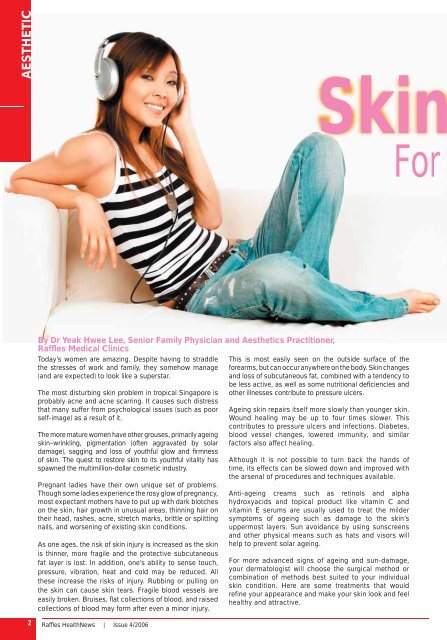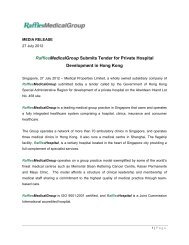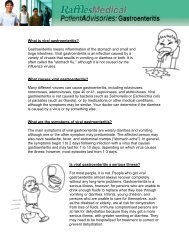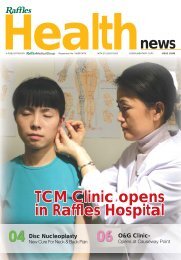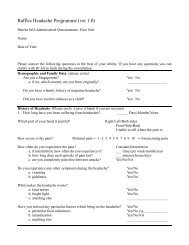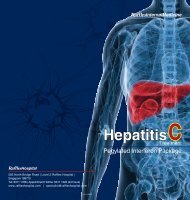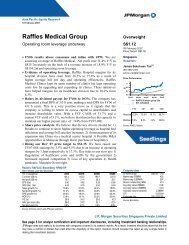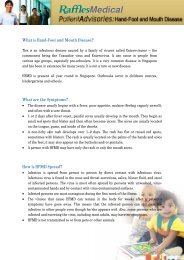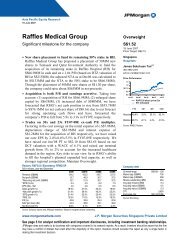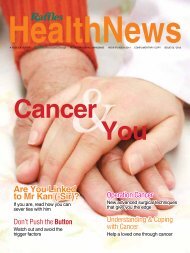News - Raffles Medical Group
News - Raffles Medical Group
News - Raffles Medical Group
You also want an ePaper? Increase the reach of your titles
YUMPU automatically turns print PDFs into web optimized ePapers that Google loves.
AESTHETIC<br />
Skin<br />
For<br />
By Dr Yeak Hwee Lee, Senior Family Physician and Aesthetics Practitioner,<br />
<strong>Raffles</strong> <strong>Medical</strong> Clinics<br />
Today’s women are amazing. Despite having to straddle<br />
the stresses of work and family, they somehow manage<br />
(and are expected) to look like a superstar.<br />
The most disturbing skin problem in tropical Singapore is<br />
probably acne and acne scarring. It causes such distress<br />
that many suffer from psychological issues (such as poor<br />
self-image) as a result of it.<br />
The more mature women have other grouses, primarily ageing<br />
skin–wrinkling, pigmentation (often aggravated by solar<br />
damage), sagging and loss of youthful glow and firmness<br />
of skin. The quest to restore skin to its youthful vitality has<br />
spawned the multimillion-dollar cosmetic industry.<br />
Pregnant ladies have their own unique set of problems.<br />
Though some ladies experience the rosy glow of pregnancy,<br />
most expectant mothers have to put up with dark blotches<br />
on the skin, hair growth in unusual areas, thinning hair on<br />
their head, rashes, acne, stretch marks, brittle or splitting<br />
nails, and worsening of existing skin conditions.<br />
As one ages, the risk of skin injury is increased as the skin<br />
is thinner, more fragile and the protective subcutaneous<br />
fat layer is lost. In addition, one’s ability to sense touch,<br />
pressure, vibration, heat and cold may be reduced. All<br />
these increase the risks of injury. Rubbing or pulling on<br />
the skin can cause skin tears. Fragile blood vessels are<br />
easily broken. Bruises, flat collections of blood, and raised<br />
collections of blood may form after even a minor injury.<br />
This is most easily seen on the outside surface of the<br />
forearms, but can occur anywhere on the body. Skin changes<br />
and loss of subcutaneous fat, combined with a tendency to<br />
be less active, as well as some nutritional deficiencies and<br />
other illnesses contribute to pressure ulcers.<br />
Ageing skin repairs itself more slowly than younger skin.<br />
Wound healing may be up to four times slower. This<br />
contributes to pressure ulcers and infections. Diabetes,<br />
blood vessel changes, lowered immunity, and similar<br />
factors also affect healing.<br />
Although it is not possible to turn back the hands of<br />
time, its effects can be slowed down and improved with<br />
the arsenal of procedures and techniques available.<br />
Anti-ageing creams such as retinols and alpha<br />
hydroxyacids and topical product like vitamin C and<br />
vitamin E serums are usually used to treat the milder<br />
symptoms of ageing such as damage to the skin’s<br />
uppermost layers. Sun avoidance by using sunscreens<br />
and other physical means such as hats and visors will<br />
help to prevent solar ageing.<br />
For more advanced signs of ageing and sun-damage,<br />
your dermatologist will choose the surgical method or<br />
combination of methods best suited to your individual<br />
skin condition. Here are some treatments that would<br />
refine your appearance and make your skin look and feel<br />
healthy and attractive.<br />
2<br />
<strong>Raffles</strong> Health<strong>News</strong> | Issue 4/2006


